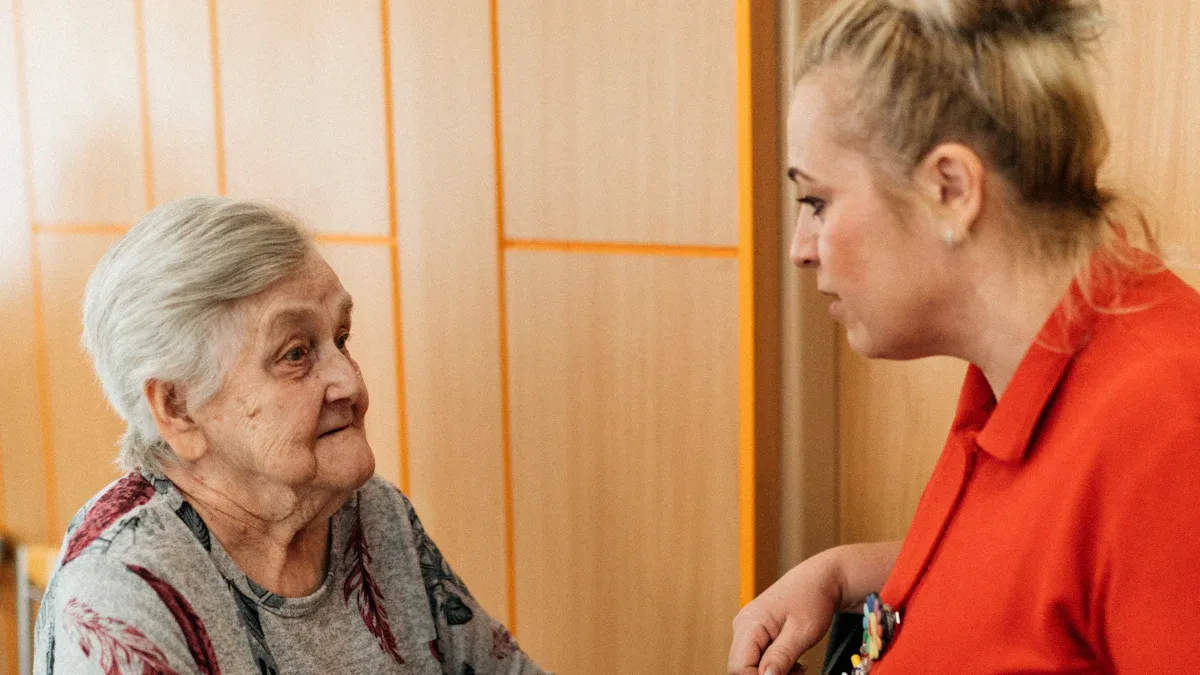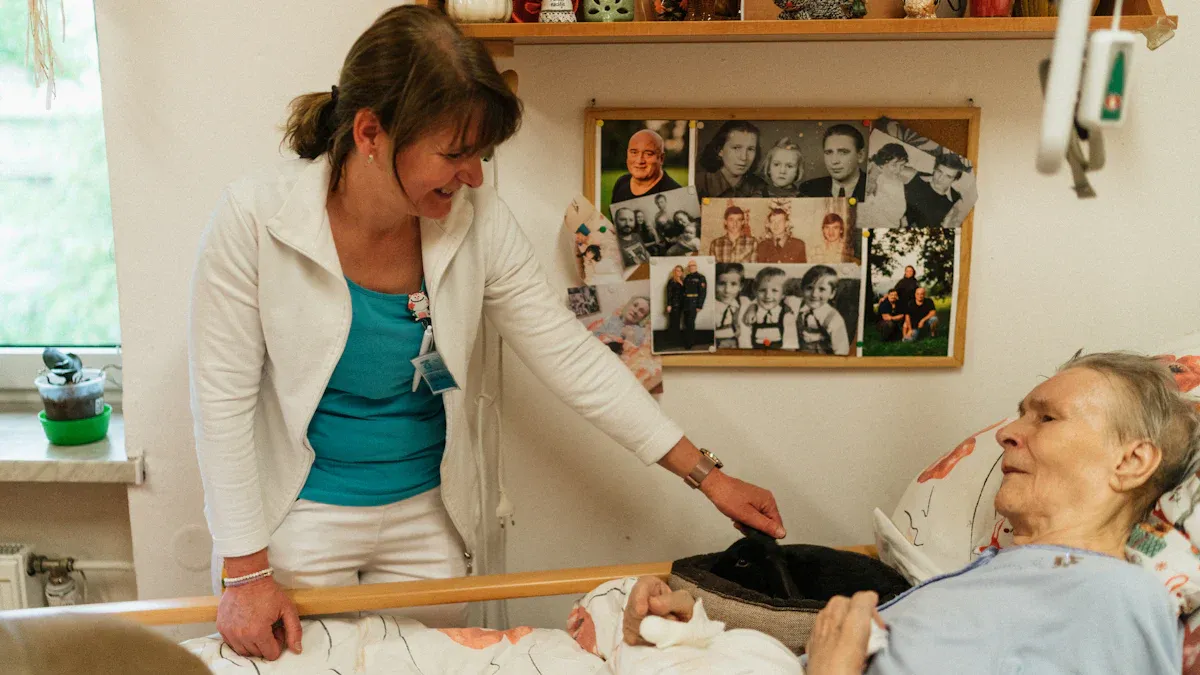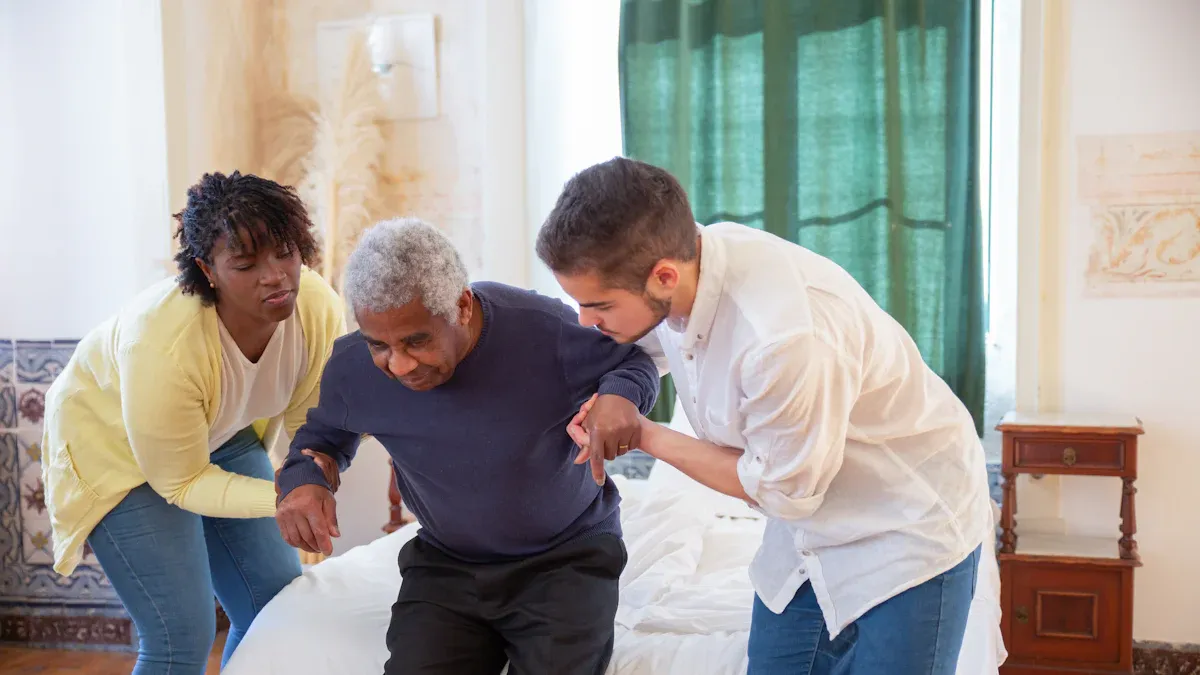Top Tips for Caregivers to Communicate Effectively with Patients

Communication is the heart of caregiving. When you connect with patients through clear and empathetic conversations, you build trust and show them you care. This trust helps patients feel safe and understood, which can lead to better health outcomes. Studies show that effective communication—both verbal and non-verbal—boosts patient satisfaction, improves the quality of care, and even enhances overall health.
But let’s be honest—keeping communication smooth isn’t always easy. Patients may feel overwhelmed or hesitant to share their concerns. You might struggle to find the right words or balance emotions during tough conversations. That’s why adopting healthy communication strategies: caregiver and patient can make all the difference.
Key Takeaways
Listen carefully. Pay attention to patients' words and feelings to show care.
Gain trust by being kind. Understand their views and respect their emotions.
Speak simply. Avoid hard medical words so patients understand better.
Make them feel at ease. Give privacy and time for them to share.
Include family members. Keep them updated and let them help with decisions.
Healthy Communication Strategies: Caregiver and Patient

Active Listening
Focusing on the patient’s words and emotions
Active listening is more than just hearing—it’s about truly understanding what the patient is saying. When you focus on their words and emotions, you show them that their concerns matter. For example, during mealtime, nurse-aide-initiated communication that includes active listening has been shown to improve patient-centered outcomes. You can enhance this by paying attention to their tone, choice of words, and even pauses.
Avoiding interruptions and distractions
Interruptions can make patients feel dismissed. To avoid this, create a quiet space free from distractions like phones or background noise. Nonverbal cues, such as nodding or maintaining eye contact, also reinforce your attentiveness. Research highlights that nonverbal communication, like touch or gestures, plays a crucial role in improving communication quality and patient satisfaction.
Building Empathy and Trust
Understanding the patient’s perspective
Empathy begins with seeing the world through the patient’s eyes. Ask open-ended questions like, “How are you feeling about this treatment?” This approach helps you understand their perspective and builds trust. Studies confirm that empathy reduces anxiety and improves patient engagement, satisfaction, and adherence to treatment plans.
Showing genuine care and concern
Patients can sense when you genuinely care. Small gestures, like remembering their preferences or offering a kind word, go a long way. Research shows that empathic relationships not only improve satisfaction but also reduce disputes and enhance overall outcomes.
Clarity and Simplicity
Using plain, jargon-free language
Medical jargon can confuse patients. Instead, use simple, clear language to explain their condition or treatment. For example, instead of saying “hypertension,” you could say “high blood pressure.” Studies emphasize that plain language fosters better understanding and encourages two-way conversations.
Confirming understanding through feedback
After explaining something, ask the patient to repeat it back in their own words. This ensures they’ve understood and gives you a chance to clarify if needed. Techniques like this show patients that you value their engagement and want them to feel confident about their care.
Healthy communication strategies: caregiver and patient interactions thrive when you actively listen, build empathy, and keep things simple. These steps not only improve patient outcomes but also strengthen your bond with those you care for.
Practical Communication Tips
Verbal Communication
Speaking with a calm and reassuring tone
Your tone of voice can set the stage for a positive interaction. Speaking calmly and reassuringly helps patients feel safe and understood. Research shows that using a calm tone improves patient satisfaction and health literacy. It also enhances patient-centered outcomes, making them more likely to engage in their care.
Here are a few tips to keep in mind:
Sit down when speaking with patients to create a sense of connection.
Use a steady, warm tone to convey empathy and understanding.
Avoid rushing your words, as this can make patients feel anxious.
Asking open-ended questions to encourage dialogue
Open-ended questions invite patients to share their thoughts and feelings. Instead of asking, “Are you in pain?” try, “Can you describe how you’re feeling today?” This approach encourages more detailed responses and helps you understand their needs better. It also shows that you value their input, which builds trust and strengthens your relationship.
Non-Verbal Communication
Maintaining appropriate eye contact
Eye contact is a powerful way to show you’re present and engaged. Studies highlight that maintaining eye contact fosters a supportive environment and improves patient outcomes, such as shorter hospital stays and better self-esteem. However, balance is key—too much eye contact can feel intimidating, while too little may seem dismissive.
Using positive body language, such as nodding and smiling
Your body language speaks volumes. A simple nod or a warm smile can reassure patients and make them feel valued. Research confirms that non-verbal cues like these enhance patient-centered care and improve understanding. Adopting an open posture and leaning slightly forward can also signal that you’re actively listening.
Creating a Comfortable Environment
Ensuring privacy and comfort during conversations
A comfortable setting can make a big difference in how patients open up. Noisy or crowded spaces can hinder communication, while a quiet, private area encourages patients to share freely. Small gestures, like offering a chair or adjusting the lighting, can make patients feel more at ease.
Allowing patients time to express themselves fully
Patience is key when communicating with patients. Rushing them can lead to misunderstandings or missed details. Give them the time they need to articulate their thoughts. This not only improves communication but also builds trust and reduces anxiety. When patients feel heard, they’re more likely to engage with their care plan.
Healthy Communication Strategies: Caregiver and Patient interactions thrive when you combine verbal and non-verbal techniques with a comfortable environment. These practices create a foundation for trust and understanding, leading to better outcomes for everyone involved.
Handling Challenging Conversations

Addressing Sensitive Topics
Approaching difficult subjects with compassion
Talking about sensitive topics can feel overwhelming for patients. You can make these conversations easier by creating a calm and supportive environment. Speak slowly and clearly, and introduce the subject with care. For example, instead of diving straight into a tough topic, you might say, “I’d like to discuss something important with you. Let me know if you’re ready.” This approach helps reduce anxiety and encourages open dialogue.
Empathetic communication is key here. Acknowledge the patient’s feelings and validate their emotions. Saying something like, “I understand this might be hard to talk about,” shows that you care and are there to support them. Patients often feel more comfortable sharing their thoughts when they sense genuine empathy.
Using “I” statements to express concerns without blame
When addressing concerns, using “I” statements can prevent the patient from feeling blamed or judged. For instance, instead of saying, “You’re not following the treatment plan,” try, “I’m concerned about how the treatment plan is working for you.” This shifts the focus to your perspective and opens the door for a constructive conversation.
Empathetic communication and thoughtful phrasing can transform challenging discussions into opportunities for connection and understanding.
Managing Emotional Reactions
Staying calm and composed during emotional outbursts
Patients may sometimes express frustration or sadness. Staying calm and composed during these moments is crucial. Sitting down while speaking can help create a sense of trust and intimacy, which may ease their emotions. If the conversation becomes heated, take a moment to breathe and respond with patience.
The BATHE technique—a structured approach to understanding emotions—can also help. It involves asking open-ended questions like, “What’s been bothering you the most?” This method fosters rapport and helps patients feel heard.
Validating the patient’s feelings without judgment
When emotions run high, patients need to feel that their feelings are valid. Simple phrases like, “It’s okay to feel this way,” or “I can see why this is upsetting,” can make a big difference. Avoid dismissing their emotions or rushing to solutions. Instead, focus on listening and offering reassurance.
A calm demeanor and validation of emotions can turn emotional outbursts into meaningful conversations.
Resolving Conflicts
Finding common ground and solutions
Conflicts can arise when patients feel misunderstood or unheard. To resolve these issues, focus on finding common ground. Ask questions like, “What do you think would work best for you?” This invites collaboration and shows that you value their input. Sharing information openly and inviting their opinions can also minimize misunderstandings.
Knowing when to involve a mediator or professional
Sometimes, conflicts may require outside help. If you’re unable to reach a resolution, consider involving a mediator or healthcare professional. Their expertise can provide a fresh perspective and help navigate the situation. Remember, seeking help isn’t a sign of failure—it’s a step toward better care and understanding.
Effective conflict resolution relies on mutual respect, open communication, and knowing when to seek additional support.
Leveraging Tools and Resources
Technology for Communication
Video calls for remote caregiving
Technology has made caregiving more flexible, especially when you can’t be physically present. Video calls allow you to stay connected with patients, offering emotional support and monitoring their well-being from afar. For example, caregivers working with individuals with dementia have found that video calls improve communication and strengthen relationships.
Key Findings | Implications |
|---|---|
This suggests that video calls and apps may improve the quality of relationships in caregiving. | |
Utilizing technology can increase the frequency and duration of social interactions. | This can lead to more involvement from caregivers, positively affecting their relationship with care recipients. |
While more research is needed to fully validate these benefits, video calls remain a practical tool for remote caregiving.
Apps for tracking patient needs and preferences
Caregiving apps can simplify your daily tasks. They help you track medications, appointments, and even patient preferences. Tools like CareNav go a step further by offering secure communication, assessments, and ongoing consultations. This HIPAA-compliant system ensures privacy while giving you access to counseling and education resources. Caregivers using such tools report high satisfaction, as these apps make caregiving more organized and less stressful.
Caregiver Training Programs
Workshops on communication skills
Workshops can transform how you interact with patients. They focus on building empathy, recognizing your strengths, and teaching coping strategies. These sessions not only improve your communication skills but also reduce burnout. By understanding patient needs better, you can offer emotional support and handle challenges with confidence.
Online courses and certifications
If attending workshops isn’t feasible, online courses are a great alternative. These programs cover everything from managing patient conditions to enhancing your listening skills. They’re flexible, allowing you to learn at your own pace while gaining valuable certifications. Education like this helps you feel more prepared and reduces frustration in caregiving.
Support Networks
Joining caregiver support groups
You don’t have to navigate caregiving alone. Support groups connect you with others who understand your challenges. Sharing experiences in these groups can provide emotional relief and practical advice. They’re a safe space where you can learn from others and feel less isolated.
Sharing experiences and learning from others
Talking to fellow caregivers can be eye-opening. You’ll discover new strategies and gain insights that make caregiving easier. Whether it’s through in-person meetings or online forums, these interactions remind you that you’re part of a supportive community.
Leveraging tools, training, and support networks can make caregiving more manageable and rewarding. These resources empower you to communicate effectively and provide the best care possible.
The Role of Family and Collaboration
Involving Family Members
Keeping family informed about the patient’s needs
Keeping family members in the loop is essential for effective caregiving. When families understand the patient’s condition and treatment plan, they can make better decisions and provide emotional support. Research shows that clear communication between healthcare providers and families improves decision-making and patient satisfaction, especially in critical situations like end-of-life care. Families who are well-informed feel less stressed and more confident in their choices, which benefits both the patient and the caregivers.
Key Findings | Description |
|---|---|
Family Involvement | Enhances communication and decision-making in end-of-life care. |
Emotional Support | Interventions support patients and families emotionally and psychologically. |
Information Provision | Clear communication helps families understand patient conditions and treatments. |
Satisfaction | Family-centered care leads to greater satisfaction with treatment decisions. |
Reduced Stress | Well-informed families experience less stress during critical decisions. |
Encouraging family participation in care decisions
You can strengthen the caregiving process by encouraging family members to take an active role in care decisions. Ask for their input during discussions about treatment options or daily routines. This not only lightens your load but also ensures the patient’s preferences are respected. When families feel involved, they’re more likely to collaborate effectively and support the patient’s care plan.
Collaborative Care Teams
Coordinating with healthcare professionals
Working with a team of healthcare professionals can make caregiving more manageable. Coordination ensures everyone is on the same page, from doctors to therapists. This teamwork improves patient outcomes and care efficiency. For example, when roles are clearly defined, workflows become smoother, and patients receive better attention. A well-coordinated team also fosters trust and communication, creating a positive environment for everyone involved.
Sharing responsibilities to reduce caregiver stress
Caregiving can be overwhelming, but sharing responsibilities with a collaborative team can ease the burden. Team-based care creates a supportive atmosphere that reduces stress and burnout. Here’s how teamwork helps:
It enhances collaboration among professionals, leading to better patient care.
It streamlines workflows, allowing you to focus on what matters most.
It reduces administrative tasks, giving you more time to care for the patient.
By working together, you can create a balanced approach that benefits both you and the patient. A supportive team makes caregiving less stressful and more rewarding.
Effective communication starts with active listening, empathy, and clarity. When you truly hear your patients, show genuine care, and use simple language, you create a foundation of trust. These strategies not only improve patient outcomes but also make your caregiving journey more rewarding.
Applying these tips takes practice, but it’s worth the effort. Continuous learning, like attending workshops or exploring online courses, can sharpen your skills and boost your confidence. Training helps you understand patient needs better, manage stress, and build stronger connections. When you combine these skills with collaboration and support, you create a positive environment for both you and your patients.
Remember, every conversation is an opportunity to strengthen your bond and provide the best care possible. Keep learning, stay empathetic, and watch your relationships flourish.
FAQ
How can I improve my communication skills as a caregiver?
Improving communication starts with practice. Focus on active listening, use simple language, and show empathy. You can also join workshops or take online courses to sharpen your skills. Remember, every interaction is a chance to learn and grow.
What should I do if a patient doesn’t want to talk?
Respect their silence but let them know you’re available when they’re ready. Use non-verbal cues like a warm smile or gentle nod to show support. Sometimes, just being present can make a big difference.
How do I handle a patient who gets upset during conversations?
Stay calm and composed. Acknowledge their feelings by saying, “I understand this is hard.” Avoid arguing or dismissing their emotions. Instead, focus on listening and offering reassurance. Patience and empathy can help de-escalate the situation.
Are there tools to help me communicate better with patients?
Yes! Apps like CareNav can track patient needs and preferences. Video calls are great for remote caregiving. These tools make communication easier and more organized, helping you stay connected and informed.
How can I involve family members in caregiving?
Keep them informed about the patient’s needs and care plan. Encourage them to participate in decisions and daily routines. Collaboration not only lightens your load but also ensures the patient feels supported by their loved ones.
💡 Tip: Open communication with family members strengthens teamwork and improves caregiving outcomes.
See Also
Exploring Choroid Plexus Carcinoma: Symptoms And Treatment Options
An In-Depth Overview Of Various Types Of Cancer
Join Banish Cancer: A Place For Hope And Resilience
Understanding Cervical Cancer: Key Symptoms To Watch For
Essential Information Regarding Symptoms Of Adrenocortical Carcinoma
